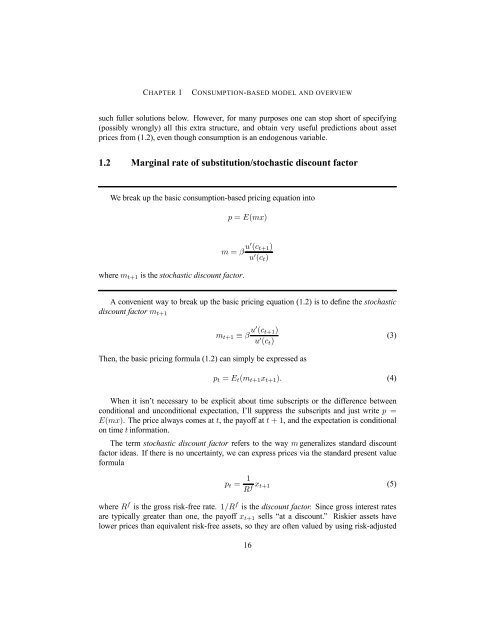Asset Pricing John H. Cochrane June 12, 2000
Asset Pricing John H. Cochrane June 12, 2000
Asset Pricing John H. Cochrane June 12, 2000
Create successful ePaper yourself
Turn your PDF publications into a flip-book with our unique Google optimized e-Paper software.
CHAPTER 1 CONSUMPTION-BASED MODEL AND OVERVIEW<br />
such fuller solutions below. However, for many purposes one can stop short of specifying<br />
(possibly wrongly) all this extra structure, and obtain very useful predictions about asset<br />
prices from (1.2), even though consumption is an endogenous variable.<br />
1.2 Marginal rate of substitution/stochastic discount factor<br />
We break up the basic consumption-based pricing equation into<br />
where mt+1 is the stochastic discount factor.<br />
p = E(mx)<br />
m = β u0 (ct+1)<br />
u 0 (ct)<br />
A convenient way to break up the basic pricing equation (1.2) is to define the stochastic<br />
discount factor mt+1<br />
mt+1 ≡ β u0 (ct+1)<br />
u 0 (ct)<br />
Then, the basic pricing formula (1.2) can simply be expressed as<br />
(3)<br />
pt = Et(mt+1xt+1). (4)<br />
When it isn’t necessary to be explicit about time subscripts or the difference between<br />
conditional and unconditional expectation, I’ll suppress the subscripts and just write p =<br />
E(mx). The price always comes at t, the payoff at t +1, and the expectation is conditional<br />
on time t information.<br />
The term stochastic discount factor refers to the way m generalizes standard discount<br />
factor ideas. If there is no uncertainty, we can express prices via the standard present value<br />
formula<br />
pt = 1<br />
xt+1<br />
(5)<br />
Rf where R f is the gross risk-free rate. 1/R f is the discount factor. Since gross interest rates<br />
are typically greater than one, the payoff xt+1 sells “at a discount.” Riskier assets have<br />
lower prices than equivalent risk-free assets, so they are often valued by using risk-adjusted<br />
16
















